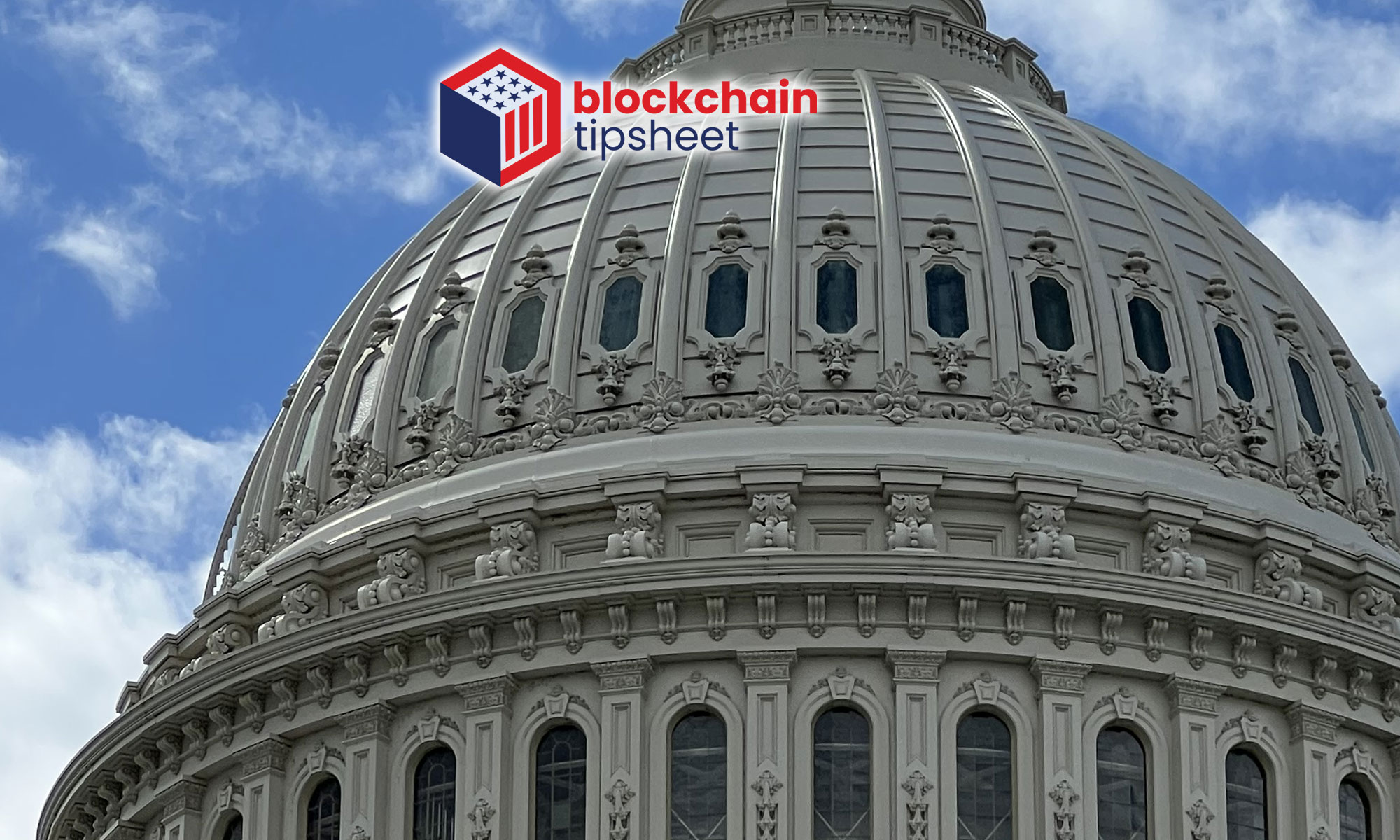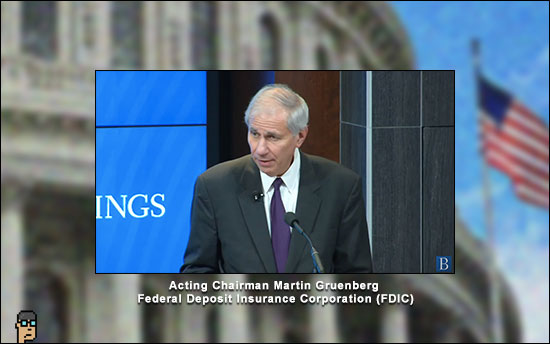Today at a Brookings event in Washington, D.C., Federal Deposit Insurance Corporation (FDIC) Acting Chairman Martin Gruenberg discussed his government purview and how crypto assets are and should be addressed by banks. Video of the event is here.
Though recognizing blockchain’s innovative qualities, he largely saw huge risk to the banking system from crypto and suggested there is broader FDIC guidance forthcoming.
As he began, Gruenberg noted that innovation is a double-edged sword saying that financial products such as credit default swaps were seen as innovative, but helped cause the Great Financial Crisis in 2008-9. The accessibility and convenience of crypto was attractive to consumers and banks, but Gruenberg believed it was difficult for the banks to move quickly given the dynamic nature of the new assets as tech, business model and use cases are subject to change in short order.
Don’t mix the message
For background, in late July, the FDIC released guidance on how banks should deal with the crypto ecosystem. The over-arching concern from the FDIC was the consumer believing they are insured when they are not. According to the FDIC, non-banks were offering uninsured crypto asset products and insured bank deposit products but that doesn’t mean for the consumer using these products that their crypto product or asset is insured.
See:
In his speech, Acting Chairman Gruenberg claimed that consumers are often finding they have no one to turn to with distributed ledger technology. If something goes wrong, transactions were difficult to track on the blockchain – a contradiction of pro-crypto advocates who claim it is trackable, sometimes too trackable and presents privacy challenges.
Gruenberg said that growth in the crypto industry has attracted insured banks. He stressed the importance for banks to make sure what they are doing is permissible, operating in safe and sound manner, have measures and controls for safety, and ensure compliance of all relevant laws such as KYC, AML, BSA and consumer protection rules.
Referencing guidance from April, he noted that the FDIC asked banks to start supplying information on crypto products which they may provide to consumers so that the FDIC could advise banks about what they are offering.
Citing safety and soundness, familiarity, and dynamic nature of crypto as reasons for the FDIC to take a closer look, he added, “You need only to read the news to know the risks,” identifying bankruptcies earlier in the year.
Gruenberg believed that consumers may not have been aware of the risks and, moreover, insured institutions needed to control risks associated with third-party firms including crypto.
He emphasized the risk for the banking system – a consistent theme of his speech.
Stablecoins
Moving on to stablecoins, Acting Chairman Gruenberg began with Bitcoin and Ethereum saying basically that the assets were backed by “sentiment.” On stablecoins, which he said are backed by a pool of assets that are “purported” to be backed by U.S. Treasury securites and commercial paper among other assets. According to Gruenberg, “There has been no demonstration of their value to the broader payment system.”
He did admit a payment stablecoin, and the distributed ledger technology, “may” have a pivotal role in the payment system. Gruenberg seemed hopeful that this could be potentially transformational and gave historical examples of its potential.
But then he returned to risk themes saying, “We would do well to keep our history in mind” as it gives good insight into the value and risks of crypto. He seemed reluctant to admit that payment stablecoins were anything better than what FedNow‘s payment system would offer such as cost-effectiveness, real-time capabilities and around-the-clock payments to name a few
Acting Chair Gruenberg listed three features he’d like to see for payment stablecoins:
-
- “Prudential” regulation
- Issuance through a bank subsidiary
- Backing dollar-for-dollar short-term U.S. Treasury assets.
Next, Gruenberg rejected a core crypto theme and said he believe stablecoins need to be on a permissioned ledger system which would be critical in addressing terrorism financing and sanctions – and therefore enabling AML/KYC/BSA functionality.
He reiterated the that the development of a payment stablecoing could fundamentally alter the banking system and disintermediate today’s banks by altering lending and harm the viability of current lending banks. That is to say: creating a new “shadow banking” system is hugely destabilizing.
So, stablecoins through insured banks versus non-banks is a key question to be addressed within the FDIC’s world. Gruenberg added, “When we consider where payment stablecoins fit in the regulatory landscape,” he believed that states need to understand how this relates to the issuance of money transmitter licenses. There is no national money transmitter licenses in the United States.
Stablecoins could disintermediate local banks from their local communities according to Gruenberg. He went on to describe the possiblities of bank runs and consumer protectioin issues with more complex crypto assets including fraud.
Noting crypto wallets, he sprinkled a bit of hope about crypto and believed these wallets should be created such that they reach under-banked and un-banked households and added that internet connectivity will be another wildcard in reaching underserved with new technologies.
Legislation
Gruenberg said that federal agencies have authority already to oversee some areas of crypto. But consumer protection needed to be addressed and suggested a proper payment stablecoin should be met by end-to-end by legislation which may explain the ongoing delays in the House Financial Services Committee with stablecoin legislation led by Chairman Maxine Waters (D, CA) and Ranking Member Patrick McHenry (R, NC).
Concluding, he emphasized a thoughtful approach to the novel, complex risks associated with crypto. Supervised banks will continue to be under the microscope of the FDIC for compliance, he said.
Q&A
In an onstage Q&A after his speech, Gruenberg reiterated safeguards around deposit insurance and that challenging marketing practices by some crypto firms went to the core of the FDIC’s mission of maintaining public confidence in the banking system. He said “several instances” have occurred regarding crypto companies claiming their crypto assets were FDIC insured and emphasized this is illegal. “People have been misled and there have been consequences.”
On financial inclusion, Gruenberg expanded on his earlier statement regarding ATM’s and how they addressed efficient distribution with consumers – a good thing. It wasn’t clear to him that crypto provided any benefit, he said, and that it’s been a vehicle of investment and trading rather than reaching new communities.
In answer to another question on a 2021 survey by the FDIC, the long awaited survey results would be coming out next Tuesday, October 25 which may have some impact on guidance on crypto within the banking system.
As the longest serving member of Financial Stability Oversight Council (FSOC), Acting Chairman Gruenberg demurred on whether FSOC can bring its power to bear in crypto in terms of “designation authorities.” Noting the recent FSOC report (PDF) on digital assets, he seemed to say this is TBD.
Finally, permissioned versus non-permissioned chains came up. He reiterated the AML/KYC concerns around non-permissioned seemed like a huge risk.

